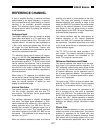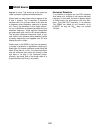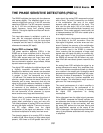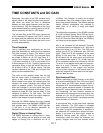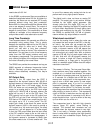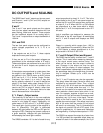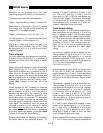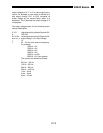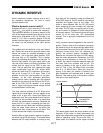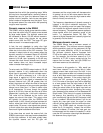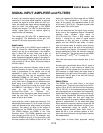
3-14
SR850 Basics
deviations can be expanded up to 100 times
before they exceed full scale (at 1 mV sensitivity).
The analog output with offset and expand is
Output = (signal/sensitivity - offset) x Expand x10V
where offset is a fraction of 1 (50%=0.5), expand
is an integer from 1 to 256 and the output can not
exceed 10 V. In the above example,
Output = (0.91mV/1mV - 0.9) x 10 x 10V = 1V
for a signal which is 10 µV greater than the 0.9 mV
nominal. (Offset = 0.9 and expand =10).
The X and Y offset and expand functions in the
SR850 are output functions, they do NOT affect
the calculation of R or θ. R has its own output
offset and expand.
Trace displays
Only data traces may be displayed on the screen.
In order to display the quantity X, it is necessary to
define a trace to be X and then choose to display
that trace.
Output offsets ARE reflected in data trace displays
which depend upon X, Y or R. For example, a
trace which is defined as X is affected by the X
offset. When the X output is offset to zero, the dis-
played trace value on the screen will drop to zero
also. Any display which is showing a trace which is
affected by a non-zero offset will display a high-
lighted Offst indicator at the lower left of the
display.
Output expands do NOT increase the displayed
values of X, Y or R in data traces. Expand increas-
es the resolution of the X, Y or R value used to
calculate the trace value. For example, a trace
which is defined as X does not increase its dis-
played value when X is expanded. This is because
the expand function increases the resolution with
which the signal is measured, not the size of the
input signal. The displayed value will show an
increased resolution but will continue to display
the original value of X minus the X offset. Any dis-
play which is showing a trace which is affected by
a non-unity expand will display a highlighted Expd
indicator at the lower left of the display.
Complex data traces are displayed and stored in
the actual units of the computed quantity. For
example, if a trace is defined as X•θ/Aux 1 and
X=1 mV, θ=37°, and Aux 1= 2.34 V, then the
trace value is 0.001 x 37/2.34 Volt•degrees per
Volt or 0.01581 Vdeg/V. This value is not changed
by the sensitivity (X is the input signal, not the
output voltage) or by X expand. An X offset will,
however, change the value of this trace.
Trace output scaling
What about CH1 or CH2 outputs proportional to
data traces which are not simply X, Y, R or θ? If a
trace is defined as A•B/C, then the trace output
voltage depends upon the values of each parame-
ter. Trace output voltages are calculated by deter-
mining the output voltages for the individual
quantities, A, B and C. The individual output volt-
ages (-10 V to +10 V) are then combined using the
trace definition to determine the trace output
voltage.
For example, suppose a trace is defined as X/R.
The parameters X and R scale as 10 V for a full
scale input signal. If the sensitivity is 1 V and the
measured values are X=500 mV and R=1 V, the
X output would be 5 V and the R output would be
10 V. The trace output voltage is simply
(X=5 V)/(R=10 V)=0.5 V.
Output voltages for traces which are defined as A,
B, A/C, B/C or A•B/C are calculated using the
output voltages for A, B and C. Traces defined as
A•B (A,B≠1, C=1) have output voltages which are
the product of the A and B output voltages divided
by 10.
For example, suppose a trace is defined as X•θ.
The parameter X scales as 10 V for a full scale
input signal and θ scales as 10 V for 180° of phase
shift. If the measured X is 1 V on the 1 V sensitivi-
ty, X would be 100% of full scale or 10 V. If the
phase is 180°, then θ is also 10 V. The trace
output voltage is thus, (X=10 V)•(θ=10 V)/10=10 V.
The extra factor of 10 allows products of two full
scale quantities to be output.
X, Y and R output offsets ARE reflected in trace
outputs which depend upon X, Y or R. For exam-
ple, a trace which is defined as X and output
through CH1 or CH2 is affected by the X offset.
When the X output is offset to zero, the trace
output voltage will drop to zero also.
Output expands DO increase the output voltage of
X, Y or R in trace outputs. Expand increases the




